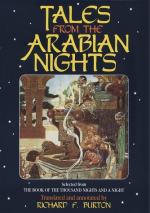The charming history of Prince Ahmad and his fairy bride is “conspicuous from its absence” in all these versions, but it re-appears in the Italian collection of Nerucci: “Novelle Popolari Montalesi,” No. xl., p. 335, with some variations from Galland’s story:
A certain king had three daughters, and a neighbouring king had three sons, who were much devoted to the chase. They arrived at the city of the first king, and all fell in love with his daughter[FN#416] and wanted to marry her. Her father said it was impossible to content them all, but if one of them would ask her, and if he pleased her, he would not oppose the marriage. They could not agree which it was to be, and her father proposed that they should all travel, and the one who at the end of six months brought the most beautiful and wonderful present should marry her. They set out in different directions and at the end of six months they meet by appointment at a certain inn. The eldest brings a magic carpet on which he is wafted whithersoever he will. (It goes a hundred miles in a day.) The second brings a telescope which shows whatever is happening a hundred miles away. The youngest brings three stones of a grape, one of which put into the mouth of a person who is dying restores him to life. They at once test the telescope by wishing to see the princess, and they find her dying—at the last gasp indeed. By means of the carpet they reach the palace m time to save her life with one of the grape-stones. Each claims the victory. Her father, almost at his wits’ end to decide the question, decrees




